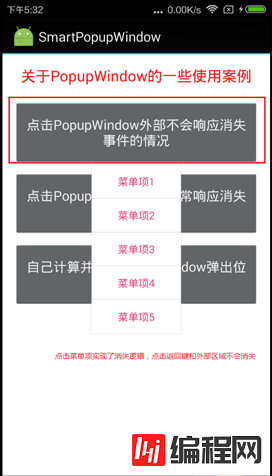刚接手PopupWindow的时候,我们都可能觉得很简单,因为它确实很简单,不过运气不好的可能就会踩到一个坑: 点击PopupWindow最外层布局以及点击返回键PopupWi
刚接手PopupWindow的时候,我们都可能觉得很简单,因为它确实很简单,不过运气不好的可能就会踩到一个坑:
点击PopupWindow最外层布局以及点击返回键PopupWindow不会消失
新手在遇到这个问题的时候可能会折腾半天,最后通过强大的网络找到一个解决方案,那就是跟PopupWindow设置一个背景
popupWindow.setBackgroundDrawable(drawable),这个drawable随便一个什么类型的都可以,只要不为空。
Demo地址:SmartPopupWindow_jb51.rar

下面从源码(我看的是Android-22)上看看到底发生了什么事情导致返回键不能消失弹出框:
先看看弹出框显示的时候代码showAsDropDown,里面有个preparePopup方法。
public void showAsDropDown(View anchor, int xoff, int yoff, int gravity) {
if (isshowing() || mContentView == null) {
return;
}
reGISterForScrollChanged(anchor, xoff, yoff, gravity);
mIsShowing = true;
mIsDropdown = true;
WindowManager.LayoutParams p = createPopupLayout(anchor.getWindowToken());
preparePopup(p);
updateAboveAnchor(findDropDownPosition(anchor, p, xoff, yoff, gravity));
if (mHeightMode < 0) p.height = mLastHeight = mHeightMode;
if (mWidthMode < 0) p.width = mLastWidth = mWidthMode;
p.windowAnimations = computeAnimationResource();
invokePopup(p);
}
再看preparePopup方法
private void preparePopup(WindowManager.LayoutParams p) {
if (mContentView == null || mContext == null || mWindowManager == null) {
throw new IllegalStateException("You must specify a valid content view by "
+ "calling setContentView() before attempting to show the popup.");
}
if (mBackground != null) {
final ViewGroup.LayoutParams layoutParams = mContentView.getLayoutParams();
int height = ViewGroup.LayoutParams.MATCH_PARENT;
if (layoutParams != null &&
layoutParams.height == ViewGroup.LayoutParams.WRAP_CONTENT) {
height = ViewGroup.LayoutParams.WRAP_CONTENT;
}
// when a background is available, we embed the content view
// within another view that owns the background drawable
PopupViewContainer popupViewContainer = new PopupViewContainer(mContext);
PopupViewContainer.LayoutParams listParams = new PopupViewContainer.LayoutParams(
ViewGroup.LayoutParams.MATCH_PARENT, height
);
popupViewContainer.setBackground(mBackground);
popupViewContainer.addView(mContentView, listParams);
mPopupView = popupViewContainer;
} else {
mPopupView = mContentView;
}
mPopupView.setElevation(mElevation);
mPopupViewInitialLayoutDirectionInherited =
(mPopupView.getRawLayoutDirection() == View.LAYOUT_DIRECTION_INHERIT);
mPopupWidth = p.width;
mPopupHeight = p.height;
}
上面可以看到mBackground不为空的时候,会PopupViewContainer作为mContentView的Parent,下面看看PopupViewContainer到底干了什么
private class PopupViewContainer extends FrameLayout {
private static final String TAG = "PopupWindow.PopupViewContainer";
public PopupViewContainer(Context context) {
super(context);
}
@Override
protected int[] onCreateDrawableState(int extraSpace) {
if (mAboveAnchor) {
// 1 more needed for the above anchor state
final int[] drawableState = super.onCreateDrawableState(extraSpace + 1);
View.mergeDrawableStates(drawableState, ABOVE_ANCHOR_STATE_SET);
return drawableState;
} else {
return super.onCreateDrawableState(extraSpace);
}
}
@Override
public boolean dispatchKeyEvent(KeyEvent event) { // 这个方法里面实现了返回键处理逻辑,会调用dismiss
if (event.geTKEyCode() == KeyEvent.KEYCODE_BACK) {
if (getKeyDispatcherState() == null) {
return super.dispatchKeyEvent(event);
}
if (event.getAction() == KeyEvent.ACTION_DOWN
&& event.getRepeatCount() == 0) {
KeyEvent.DispatcherState state = getKeyDispatcherState();
if (state != null) {
state.startTracking(event, this);
}
return true;
} else if (event.getAction() == KeyEvent.ACTION_UP) {
KeyEvent.DispatcherState state = getKeyDispatcherState();
if (state != null && state.isTracking(event) && !event.isCanceled()) {
dismiss();
return true;
}
}
return super.dispatchKeyEvent(event);
} else {
return super.dispatchKeyEvent(event);
}
}
@Override
public boolean dispatchTouchEvent(MotionEvent ev) {
if (mTouchInterceptor != null && mTouchInterceptor.onTouch(this, ev)) {
return true;
}
return super.dispatchTouchEvent(ev);
}
@Override
public boolean onTouchEvent(MotionEvent event) { // 这个方法里面实现点击消失逻辑
final int x = (int) event.getX();
final int y = (int) event.getY();
if ((event.getAction() == MotionEvent.ACTION_DOWN)
&& ((x < 0) || (x >= getWidth()) || (y < 0) || (y >= getHeight()))) {
dismiss();
return true;
} else if (event.getAction() == MotionEvent.ACTION_OUTSIDE) {
dismiss();
return true;
} else {
return super.onTouchEvent(event);
}
}
@Override
public void sendAccessibilityEvent(int eventType) {
// clinets are interested in the content not the container, make it event source
if (mContentView != null) {
mContentView.sendAccessibilityEvent(eventType);
} else {
super.sendAccessibilityEvent(eventType);
}
}
}
看到上面红色部分的标注可以看出,这个内部类里面封装了处理返回键退出和点击外部退出的逻辑,但是这个类对象的构造过程中(preparePopup方法中)却有个mBackground != null的条件才会创建
而mBackground对象在setBackgroundDrawable方法中被赋值,看到这里应该就明白一切了。
public void setBackgroundDrawable(Drawable background) {
mBackground = background;
// 省略其他的
}
setBackgroundDrawable方法除了被外部调用,构造方法中也会调用,默认是从系统资源中取的
public PopupWindow(Context context, AttributeSet attrs, int defStyleAttr, int defStyleRes) {
mContext = context;
mWindowManager = (WindowManager)context.getSystemService(Context.WINDOW_SERVICE);
final TypedArray a = context.obtainStyledAttributes(
attrs, R.styleable.PopupWindow, defStyleAttr, defStyleRes);
final Drawable bg = a.getDrawable(R.styleable.PopupWindow_popupBackground);
mElevation = a.getDimension(R.styleable.PopupWindow_popupElevation, 0);
mOverlapAnchor = a.getBoolean(R.styleable.PopupWindow_overlapAnchor, false);
final int animStyle = a.getResourceId(R.styleable.PopupWindow_popupAnimationStyle, -1);
mAnimationStyle = animStyle == R.style.Animation_PopupWindow ? -1 : animStyle;
a.recycle();
setBackgroundDrawable(bg);
}
有些版本没有,android6.0版本preparePopup如下:
private void preparePopup(WindowManager.LayoutParams p) {
if (mContentView == null || mContext == null || mWindowManager == null) {
throw new IllegalStateException("You must specify a valid content view by "
+ "calling setContentView() before attempting to show the popup.");
}
// The old decor view may be transitioning out. Make sure it finishes
// and cleans up before we try to create another one.
if (mDecorView != null) {
mDecorView.cancelTransitions();
}
// When a background is available, we embed the content view within
// another view that owns the background drawable.
if (mBackground != null) {
mBackgroundView = createBackgroundView(mContentView);
mBackgroundView.setBackground(mBackground);
} else {
mBackgroundView = mContentView;
}
mDecorView = createDecorView(mBackgroundView);
// The background owner should be elevated so that it casts a shadow.
mBackgroundView.setElevation(mElevation);
// We may wrap that in another view, so we'll need to manually specify
// the surface insets.
final int surfaceInset = (int) Math.ceil(mBackgroundView.getZ() * 2);
p.surfaceInsets.set(surfaceInset, surfaceInset, surfaceInset, surfaceInset);
p.hasManualSurfaceInsets = true;
mPopupViewInitialLayoutDirectionInherited =
(mContentView.getRawLayoutDirection() == View.LAYOUT_DIRECTION_INHERIT);
mPopupWidth = p.width;
mPopupHeight = p.height;
}
这里实现返回键监听的代码是mDecorView = createDecorView(mBackgroundView),这个并没有受到那个mBackground变量的控制,所以这个版本应该没有我们所描述的问题,感兴趣的可以自己去尝试一下
您可能感兴趣的文章:Android双击返回键退出程序的实现方法Android开发笔记之:返回键的复写onBackPressed()介绍Android中让按钮拥有返回键功能的方法及重写返回键功能Android返回键功能的实现方法Android 再按一次返回键退出程序实现思路Android中PopupWindow响应返回键并关闭的2种方法Android使alertDialog.builder不会点击外面和按返回键消失的方法Android 拦截返回键事件的实例详解
--结束END--
本文标题: android PopupWindow点击外部和返回键消失的解决方法
本文链接: https://lsjlt.com/news/22178.html(转载时请注明来源链接)
有问题或投稿请发送至: 邮箱/279061341@qq.com QQ/279061341
2024-01-21
2023-10-28
2023-10-28
2023-10-27
2023-10-27
2023-10-27
2023-10-27
回答
回答
回答
回答
回答
回答
回答
回答
回答
回答
0